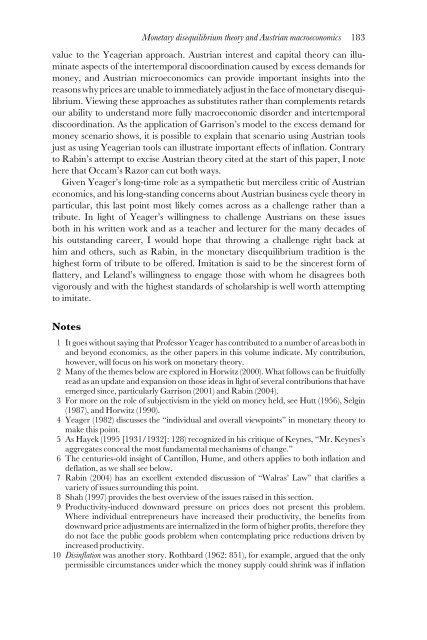Money and Markets: Essays in Honor of Leland B. Yeager
Money and Markets: Essays in Honor of Leland B. Yeager
Money and Markets: Essays in Honor of Leland B. Yeager
Create successful ePaper yourself
Turn your PDF publications into a flip-book with our unique Google optimized e-Paper software.
Monetary disequilibrium theory <strong>and</strong> Austrian macroeconomics 183value to the <strong>Yeager</strong>ian approach. Austrian <strong>in</strong>terest <strong>and</strong> capital theory can illum<strong>in</strong>ateaspects <strong>of</strong> the <strong>in</strong>tertemporal discoord<strong>in</strong>ation caused by excess dem<strong>and</strong>s formoney, <strong>and</strong> Austrian microeconomics can provide important <strong>in</strong>sights <strong>in</strong>to thereasons why prices are unable to immediately adjust <strong>in</strong> the face <strong>of</strong> monetary disequilibrium.View<strong>in</strong>g these approaches as substitutes rather than complements retardsour ability to underst<strong>and</strong> more fully macroeconomic disorder <strong>and</strong> <strong>in</strong>tertemporaldiscoord<strong>in</strong>ation. As the application <strong>of</strong> Garrison’s model to the excess dem<strong>and</strong> formoney scenario shows, it is possible to expla<strong>in</strong> that scenario us<strong>in</strong>g Austrian toolsjust as us<strong>in</strong>g <strong>Yeager</strong>ian tools can illustrate important effects <strong>of</strong> <strong>in</strong>flation. Contraryto Rab<strong>in</strong>’s attempt to excise Austrian theory cited at the start <strong>of</strong> this paper, I notehere that Occam’s Razor can cut both ways.Given <strong>Yeager</strong>’s long-time role as a sympathetic but merciless critic <strong>of</strong> Austrianeconomics, <strong>and</strong> his long-st<strong>and</strong><strong>in</strong>g concerns about Austrian bus<strong>in</strong>ess cycle theory <strong>in</strong>particular, this last po<strong>in</strong>t most likely comes across as a challenge rather than atribute. In light <strong>of</strong> <strong>Yeager</strong>’s will<strong>in</strong>gness to challenge Austrians on these issuesboth <strong>in</strong> his written work <strong>and</strong> as a teacher <strong>and</strong> lecturer for the many decades <strong>of</strong>his outst<strong>and</strong><strong>in</strong>g career, I would hope that throw<strong>in</strong>g a challenge right back athim <strong>and</strong> others, such as Rab<strong>in</strong>, <strong>in</strong> the monetary disequilibrium tradition is thehighest form <strong>of</strong> tribute to be <strong>of</strong>fered. Imitation is said to be the s<strong>in</strong>cerest form <strong>of</strong>flattery, <strong>and</strong> Lel<strong>and</strong>’s will<strong>in</strong>gness to engage those with whom he disagrees bothvigorously <strong>and</strong> with the highest st<strong>and</strong>ards <strong>of</strong> scholarship is well worth attempt<strong>in</strong>gto imitate.Notes1 It goes without say<strong>in</strong>g that Pr<strong>of</strong>essor <strong>Yeager</strong> has contributed to a number <strong>of</strong> areas both <strong>in</strong><strong>and</strong> beyond economics, as the other papers <strong>in</strong> this volume <strong>in</strong>dicate. My contribution,however, will focus on his work on monetary theory.2 Many <strong>of</strong> the themes below are explored <strong>in</strong> Horwitz (2000). What follows can be fruitfullyread as an update <strong>and</strong> expansion on those ideas <strong>in</strong> light <strong>of</strong> several contributions that haveemerged s<strong>in</strong>ce, particularly Garrison (2001) <strong>and</strong> Rab<strong>in</strong> (2004).3 For more on the role <strong>of</strong> subjectivism <strong>in</strong> the yield on money held, see Hutt (1956), Selg<strong>in</strong>(1987), <strong>and</strong> Horwitz (1990).4 <strong>Yeager</strong> (1982) discusses the “<strong>in</strong>dividual <strong>and</strong> overall viewpo<strong>in</strong>ts” <strong>in</strong> monetary theory tomake this po<strong>in</strong>t.5 As Hayek (1995 [1931/1932]: 128) recognized <strong>in</strong> his critique <strong>of</strong> Keynes, “Mr. Keynes’saggregates conceal the most fundamental mechanisms <strong>of</strong> change.”6 The centuries-old <strong>in</strong>sight <strong>of</strong> Cantillon, Hume, <strong>and</strong> others applies to both <strong>in</strong>flation <strong>and</strong>deflation, as we shall see below.7 Rab<strong>in</strong> (2004) has an excellent extended discussion <strong>of</strong> “Walras’ Law” that clarifies avariety <strong>of</strong> issues surround<strong>in</strong>g this po<strong>in</strong>t.8 Shah (1997) provides the best overview <strong>of</strong> the issues raised <strong>in</strong> this section.9 Productivity-<strong>in</strong>duced downward pressure on prices does not present this problem.Where <strong>in</strong>dividual entrepreneurs have <strong>in</strong>creased their productivity, the benefits fromdownward price adjustments are <strong>in</strong>ternalized <strong>in</strong> the form <strong>of</strong> higher pr<strong>of</strong>its, therefore theydo not face the public goods problem when contemplat<strong>in</strong>g price reductions driven by<strong>in</strong>creased productivity.10 Dis<strong>in</strong>flation was another story. Rothbard (1962: 851), for example, argued that the onlypermissible circumstances under which the money supply could shr<strong>in</strong>k was if <strong>in</strong>flation
















